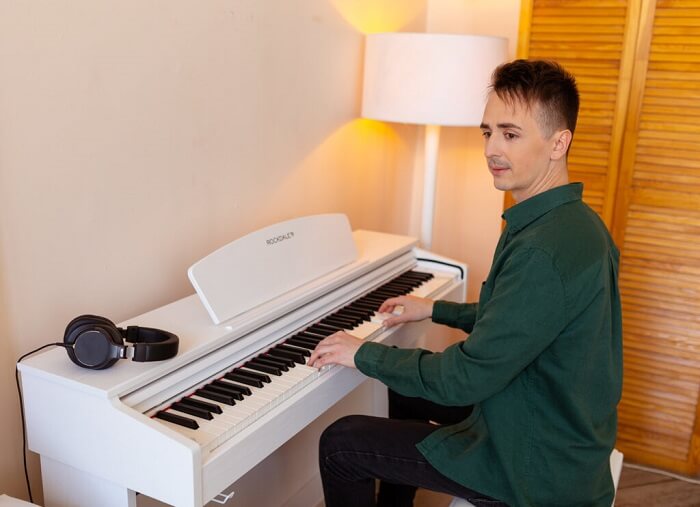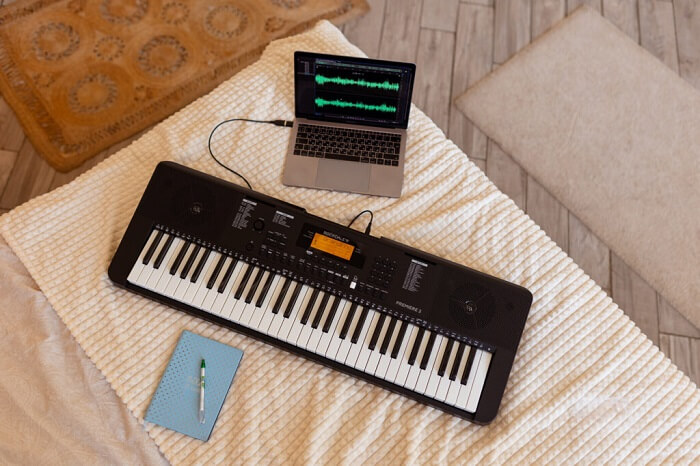Let’s start with the main question. You’ve decided to learn to play the piano. What should you acquire – a digital piano or a synthesizer? And, in general, is there a choice between electric and acoustic instruments when it comes to the piano now?
Acoustic piano or digital instrument?
If you are ready for extensive searches to find a truly well sounding acoustic piano at a reasonable price, then this is your choice. In reality, the market for such instruments turns out to be secondary because new pianos are quite expensive. A few serious nuances can lead to a refusal to learn music in life, namely:
- The weight of an acoustic piano is 200-250 kg, and its dimensions are large.
- An acoustic piano requires at least annual tuning — accordingly, it is impossible to do without searching for a good tuner and serious expenses for it.
- High probability of conflicts with neighbors — the volume level of a regular acoustic piano is not adjustable, and even the presence of a damper does not solve this problem.
Myth of acoustic pianos for beginners
There is a myth that young or novice performers find it more interesting to practice on an acoustic piano because the process of sound production is evident—just open the lid of the instrument—and the entire hammer mechanism is visible. This is quite a shaky argument against the advantages of electronic keyboard instruments with their lightweight, not exceeding 40 kg even in the most exotic cases, and small dimensions. Another plus is the ability to adjust the volume of the electronic instrument or use headphones, allowing practice at any time of the day. Electronic instruments also require no tuning.
Digital piano or synthesizer?
In short, without delving into technical details, the differences between electronic pianos and synthesizers are quite blurred today. Many models of electronic pianos, like synthesizers, are equipped with auto-accompaniment systems, allowing the performer to feel like a “one-person orchestra” and the ability to choose instrument sounds. Many digital piano models have capabilities comparable to the best synthesizers — meaning musicians have extensive built-in libraries of sound samples at their disposal. However, these features do not necessarily signify a significant improvement in the quality of the instrument’s basic sound. It’s essential to evaluate only the sounds that will be used in everyday play. It’s great if there is an acoustic counterpart of the digital piano in the showroom when making a purchase. In this case, you should test the sound of the digital piano in the bass registers and compare it with the acoustic instrument. The bass sound of the digital piano should be soft and smooth, just like that of a regular instrument.
Choosing between digital piano and synthesizer for classical training
So, if the goal of your training is to acquire classical piano skills, without any doubt, choose an electronic piano. In the case of purchasing a synthesizer, let’s recall the wisdom of professionals: “Training on a synthesizer makes a good synthesizer player.” It’s not that bad; however, the choice of a specific type of instrument depends on the goal of the learning process: a career as a classical pianist or a versatile musician, whose skills will be useful not only on the big stage but also on the small stage where there may not be a grand piano or acoustic piano. Naturally, synthesizers can reproduce the sound of a grand piano or an acoustic piano, and their keyboard meets all modern performance requirements.

The focus will now shift to the keyboard itself.
Keys: quantity and quality. And more than just keys.
As is known, the keyboard of a grand piano and an acoustic piano spans 7 1/3 octaves and consists of 88 keys. An electronic piano designed for learning must have the same keyboard with full-sized keys as a regular piano.
There are also compact instruments with 76 keys, which may be sufficient for performing compositions using samples and electronic sounds.
Synthesizers make the situation a bit more complex: in the modern diversity of electronic keyboards, a home synthesizer must meet four basic requirements. These are a five-octave keyboard (61 keys), full-sized keys (again, like a piano), a dynamic keyboard (where the volume depends on the force of hitting the keys), and a set of programmed sounds and rhythms suitable for the specific user. And since we’re talking about keys, it’s essential to address a crucial yet not-so-obvious topic: keyboard types. After all, the alignment of the physical parameters of the electronic instrument’s keyboard and an acoustic piano is necessary for developing the hand positioning and all the performance techniques of a beginner pianist.
It is evident that the electronic instrument (piano or synthesizer) should respond to the musician’s playing just like an acoustic piano, and the performer should feel their keyboards the same way. Not only should the keyboard be dynamic (responsive), meaning the volume depends on the force of hitting the key, but the keys should also offer resistance when pressed. Having only a “dynamic” keyboard is not enough — constant use of only a dynamic keyboard can harm performance technique, which is unacceptable during training. For authentic playing on the instrument, it needs to be equipped with a weighted or fully-weighted keyboard that accurately conveys the sensations of pressing the keys, as when playing an acoustic piano, due to the use of a spring-lever system in the key mechanism. This is also called a “hammer-action keyboard” — clearly, it creates the sensation of the hammer striking the key. Types of fully-weighted or hammer-action keyboards are divided into graded and balanced—most digital pianos use the graded keyboard. With a graded keyboard, the keys in the lower register are slightly harder to press, and in the upper register, they are lighter, just like on acoustic pianos. A balanced keyboard also conveys the sensations of pressing, like on acoustic pianos, but without force distribution from the lower to the upper octaves. In some models of digital pianos, a semi-weighted keyboard without hammer action may be used — simply put, the keys are pressed with a certain amount of force. However, this is not the best option if you are serious about learning.

Among keyboard manufacturers, there is a clear tendency to create an excellent instrument with rich acoustic sound and perfect piano mechanics. Keyboard dynamic technologies are constantly improving and reaching the pinnacle of true mastery. Some time ago, music teachers were against teaching piano on digital counterparts due to differences in key nuances of playing technique and the formation of incorrect skills. Presently, professionals find it challenging to discern any notable distinctions between acoustic pianos and electronic instruments.